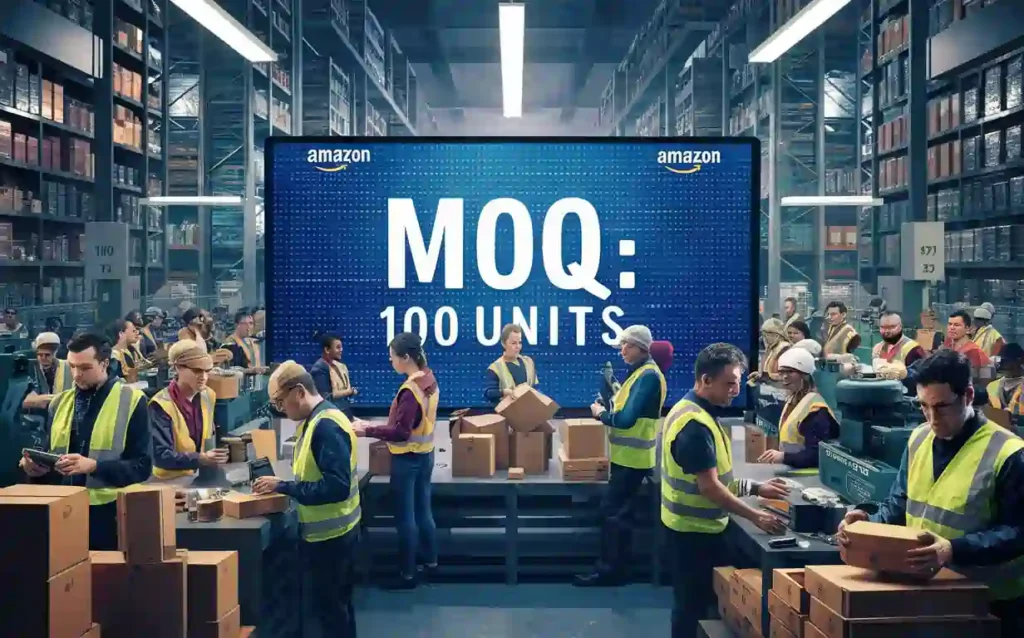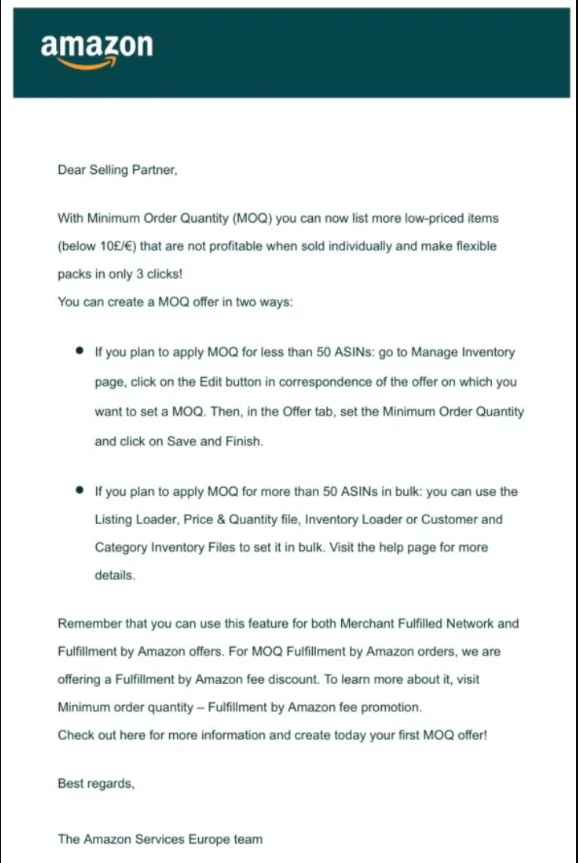
In the exponentially progressing sector of E-Commerce, Amazon sellers face a constant challenge: balancing inventory, costs, and profitability. Enter the concept of Amazon Minimum Order Quantity (MOQ) – a game-changer for those going through the Amazon marketplace.
MOQ is the smallest number of units a buyer must purchase in a single order to complete an order through FBA, and it plays a pivotal role in ensuring transactions are economically viable for sellers.
This requirement helps sellers avoid the pitfalls of handling too many small, unprofitable orders by setting a threshold that covers costs associated with shipping, packaging, and storage – ultimately enhancing profit margins.
“Amazon's success was not based on any single product or service, but on a way of doing business.“ And MOQ is undoubtedly a key part of that winning strategy.
Jeff Bezos, Amazon Founder & CEO
For buyers, Amazon MOQ can mean access to bulk pricing, potentially lowering the cost per unit. Understanding and optimizing your MOQ can lead to better inventory management, improved cash flow, and a competitive edge in the bustling marketplace.
What Is Amazon ‘Minimum Order Quantity' (MOQ)?
Minimum Order Quantity (MOQ) is a crucial concept that governs transactions between sellers and buyers on Amazon.
Simply put, MOQ acts as a threshold set by sellers to ensure profitability and cover costs associated with production, shipping, packaging, and storage.

MOQ refers to the smallest number of units a buyer must purchase in a single order.
On the Amazon marketplace, sellers have the flexibility to set their own MOQ requirements for each product listing. This means that the MOQ can vary across different products, even for the same seller.
The specified MOQ is typically displayed on the product detail page, ensuring transparency for potential buyers.
Image Source: Amazon Seller Central
When a customer attempts to place an order that falls below the set MOQ, Amazon's system will prompt them to adjust the quantity or provide a clear explanation for the minimum purchase requirement.
Benefits Of Amazon's Minimum Order Quantity

Benefits Of MOQ For Amazon Sellers
Implementing an optimal Minimum Order Quantity (MOQ) strategy can be a game-changer for Amazon sellers, unlocking a bundle of benefits that can significantly boost their bottom line and operational efficiency.
1. Improved Profit Margins
By setting a minimum order threshold, sellers can cover the associated costs of production, shipping, packaging, and storage – ultimately enhancing their profitability per transaction. This strategic move ensures that every sale contributes to a healthier profit margin, fostering long-term business sustainability.
Here's a table illustrating the potential impact of MOQ on a seller's profitability:
| Order Size | Profit Margin (without MOQ) | Profit Margin (with MOQ) |
|---|---|---|
| 1-10 units | 5% | – |
| 11-50 units | 10% | 15% |
| 51+ units | 15% | 20% |
As evident from the table, implementing an appropriate MOQ can significantly boost profit margins, especially for larger order sizes.
According to RevenueGeeks, “68% of Amazon sellers reported increased sales after implementing an optimal MOQ strategy”. This statistic highlights the significant impact MOQ can have on a seller's bottom line.
2. Better Inventory Management
MOQs empower sellers to predict and manage their stock levels more effectively, minimizing the risks of overstocking or stockouts. By aligning inventory levels with realistic demand forecasts, sellers can optimize their cash flow and reduce the burden of carrying excess inventory.
According to MarketGap, “Proper inventory management through MOQ can reduce holding costs by up to 30%“.
Additionally, a higher MOQ can lead to fewer orders being placed, which translates to lower administrative and processing costs associated with each order. This can result in substantial cost savings, especially for businesses with high-volume product lines.
| Inventory Management Metric | Low MOQ | Optimal MOQ | High MOQ |
|---|---|---|---|
| Inventory Turnover | Low | Moderate | High |
| Holding Costs | Low | Moderate | High |
| Risk of Stockouts | High | Moderate | Low |
| Risk of Obsolescence | Low | Moderate | High |
As evident from the table, striking the right balance with an optimal MOQ can lead to improved inventory turnover, moderate holding costs, and a reduced risk of stockouts or obsolescence, ultimately enhancing supply chain efficiency and profitability.
3. Operational Streamlining
With fewer small orders to process, sellers can streamline their operations, reducing time and effort spent on order handling. This newfound efficiency allows them to redirect valuable resources towards core business activities and growth strategies, propelling their Amazon ventures forward.
As stated by SmartScout, “Sellers who implemented MOQ reported a 25% reduction in order processing time“.
4. Inventory Levels and Turnover
As stated by Netstock:
“If you are ordering an MOQ that results in you purchasing more than what you need, you will be holding extra stock, which will reduce your inventory turns.”
However, in certain cases, the excess inventory from an MOQ can actually streamline your replenishment process. If you're forced to purchase more than required, you may not need to maintain as much safety stock, as the larger order quantity itself acts as a buffer.
The table below illustrates the impact of MOQ on inventory turns:
| Order Size | Inventory Turns (without MOQ) | Inventory Turns (with MOQ) |
|---|---|---|
| 1-10 units | 12 | – |
| 11-50 units | 6 | 4 |
| 51+ units | 4 | 3 |
Benefits Of MOQ For Amazon Buyers
- One of the most enticing benefits is the potential for bulk pricing discounts, as customers who meet the MOQ requirements may be eligible for lower costs per unit. This can be particularly advantageous for businesses or individuals requiring larger quantities, enabling them to maximize their purchasing power.
- Moreover, MOQs provide a gateway for buyers to access wholesale quantities directly from Amazon sellers. This can be a game-changer for resellers or businesses with high-volume demands, ensuring a steady supply of products to meet their customers' needs.
- By committing to larger orders to meet MOQs, buyers can also contribute to supply chain stability, reducing the risk of stockouts and ensuring continuity of supply.
Understanding and optimizing Amazon's Minimum Order Quantity (MOQ) can be a strategic differentiator for both Amazon Sellers and Buyers– fostering a win-win scenario for all parties involved.
Calculating Amazon MOQ!
It is crucial to calculate the optimal MOQ for each product. To do this, sellers can follow these steps:
- Forecast the demand for the product.
- Analyze the ordering and storage costs.
- Determine the total cost of ordering by multiplying the forecasted demand by the ordering costs.
- Calculate the total cost of storage by multiplying the forecasted demand by the storage cost per unit.
- Find the optimal MOQ by using the Economic Order Quantity (EOQ) formula
Economic Order Quantity (EOQ) = √(2 x Total Ordering Cost x Annual Demand
/ Total Storage Cost)
For instance, consider a product with an estimated annual demand of 12,000 units. The ordering cost is $200, while the storage cost per unit is $1. Using the EOQ formula, the calculation would be as follows:
- Estimated Annual Demand: 12,000 units
- Ordering Cost: $200
- Storage Cost per Unit: $1
- Total Ordering Cost: 12,000 x $200 = $2,400,000
- Total Storage Cost: 12,000 x $1 = $12,000
- EOQ = √(2 x $2,400,000 x 12,000 / $12,000) = 1,000 units
In this example, the optimal MOQ would be approximately 1,000 units.
Setting The Right Minimum Order Quantity
Determining the optimal Minimum Order Quantity (MOQ) for your Amazon products is a strategic decision that can significantly impact your business's profitability and operational efficiency. Here's what you need to consider:
Factors to consider while setting the Amazon MOQ:
- Product Type: The nature of your product plays a crucial role in setting the MOQ. For example, perishable items or products with a short shelf life may require a lower MOQ to avoid excess inventory and potential losses.
- Market Demand: Analyzing market demand and sales trends is essential. Products with high demand may warrant a higher MOQ to take advantage of bulk pricing and streamline order fulfillment.
- Storage Costs: Consider the costs associated with storing your inventory, including warehouse fees, insurance, and potential obsolescence. Higher storage costs may necessitate a lower MOQ to minimize holding costs.
Adjusting MOQ based on seasonal variations and sales trends:
- Seasonal Variations: If your product experiences significant seasonal fluctuations in demand, adjust your MOQ accordingly. For example, you may want to increase your MOQ before peak seasons to ensure sufficient stock and lower it during off-peak periods to avoid overstocking.
- Sales Trends: Regularly monitor your sales data and adjust your MOQ based on emerging trends. If sales are consistently higher or lower than anticipated, update your MOQ to align with the new demand patterns.
By carefully considering these factors and following a structured approach, you can set an optimal MOQ that maximizes profitability, minimizes holding costs, and ensures a smooth flow of inventory on the Amazon marketplace.
MOQ And Pricing: Finding The Sweet Spot

As an Amazon seller, striking the right balance between your Minimum Order Quantity (MOQ) and pricing strategy can be a game-changer. Here's how you can leverage MOQ to drive competitive pricing and maximize profitability:
Relationship between MOQ, Bulk Pricing, and Unit Cost:
Setting an optimal MOQ allows you to take advantage of bulk pricing discounts from suppliers. The higher the order quantity, the lower the unit cost tends to be. This relationship is crucial because it directly impacts your profit margins.
Strategies for using MOQ to drive Competitive Pricing:
- Bundle Pricing: Offer bundle deals or discounted pricing for customers who meet your MOQ. This incentivizes larger purchases and helps you move inventory faster.
- Tiered Pricing: Implement tiered pricing based on order quantity. For example, offer a lower per-unit price for orders above your MOQ, making it more attractive for customers to buy in bulk.
- Subscription Models: Consider offering subscription-based pricing for products with consistent demand. Customers can commit to a recurring order that meets your MOQ, benefiting from discounted rates.
While Amazon's MOQ policies provide certain benefits for bulk buyers, those looking for more flexible purchasing options might find AliExpress to be an excellent alternative.
MOQ Best Practices For Amazon Sellers!
As an Amazon seller, implementing effective Minimum Order Quantity (MOQ) strategies can be a game-changer for your business. Here are some best practices to help you optimize your MOQ approach:
1. Regular Review and Adjustment of MOQ Settings: The ideal MOQ for your products is not a static figure. It's essential to regularly review and adjust your MOQ settings based on changing market conditions, customer demand, and inventory levels.
2. Communication with Suppliers to Negotiate MOQ terms: Building strong relationships with your suppliers is crucial when it comes to negotiating favorable MOQ terms. Open and transparent communication can help you find mutually beneficial solutions.
3. Utilizing Sales Data to inform MOQ decisions: Analyze your sales trends, customer purchasing patterns, and inventory turnover rates to identify the optimal MOQ for each product. This data-driven approach ensures that your MOQ settings are aligned with real-world demand, minimizing the risk of overstocking or stockouts.
Here's an example of how sales data can inform MOQ decisions:
| Product | Average Monthly Sales | Current MOQ | Recommended MOQ |
|---|---|---|---|
| Product A | 500 units | 1000 units | 600 units |
| Product B | 200 units | 500 units | 300 units |
| Product C | 1200 units | 1000 units | 1500 units |
By analyzing sales data, you can identify products where the current MOQ is too high or too low and make adjustments accordingly, ensuring a more efficient inventory management process.
Implementing these best practices can help you stay ahead of the curve and leverage the power of MOQ to drive profitability, streamline operations, and maintain a competitive edge in the dynamic Amazon marketplace.
Crack Amazon MOQ Using These Super Tools!
| Feature/Tool | Helium 10 | Jungle Scout |
|---|---|---|
| MOQ Setting | Allows setting of desired MOQ levels to ensure profitability. | Typically does not provide direct MOQ setting but focuses on supplier data that includes MOQ information. |
| Supplier Database | Includes an Amazon FBA Supplier Finder tool to filter suppliers by MOQ and other criteria. | Supplier Database helps find suppliers and view their historical MOQs, aiding in decision-making. |
| Product Research | Tools like Black Box allow filtering based on MOQ, helping to identify products that meet specific inventory requirements. | Product Database provides insights into products, which indirectly helps understand typical MOQs in various categories. |
| Inventory Management | Offers tools to manage inventory levels considering MOQ, helping prevent overstocking or understocking. | Does not specifically mention MOQ management in inventory tools but provides comprehensive data for informed stocking. |
| Market Analysis | Provides market data that can influence MOQ decisions, such as demand forecasting and profitability analysis. | Extensive market data available, which can indirectly assist in setting appropriate MOQs based on market trends. |
| Educational Resources | Offers courses and tutorials that include strategies for negotiating and managing MOQ with suppliers. | Provides educational content that may cover broader topics including how MOQ impacts product sourcing and selection. |
Go Check Your Amazon MOQ Today!
mastering the art of Minimum Order Quantity (MOQ) can be a game-changer for Amazon sellers. By implementing an optimal MOQ strategy, you unlock a realm of benefits that can significantly boost your bottom line and operational efficiency.
Striking the right balance between MOQ, pricing, and inventory management is crucial for staying ahead of the curve.
Continuously monitor Market trends, Customer behavior, and Supplier negotiations to adjust your MOQ accordingly. Embrace data-driven decision-making by leveraging sales data and customer feedback to inform your MOQ decisions.
Remember, the key to success lies in finding the sweet spot that maximizes profitability while minimizing holding costs and ensuring a smooth flow of inventory. By mastering the art of MOQ, you can unlock a competitive edge, foster better inventory management, and drive long-term success in the dynamic Amazon marketplace.
So, take the leap and optimize your MOQ strategy today. Embrace the power of this strategic tool and watch your Amazon business soar to new heights.







